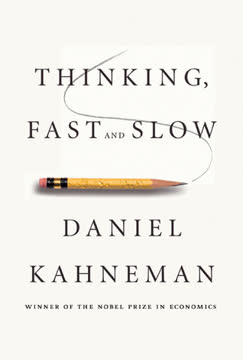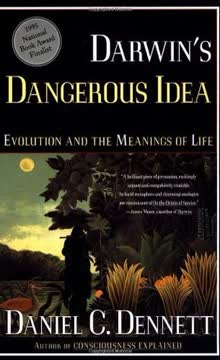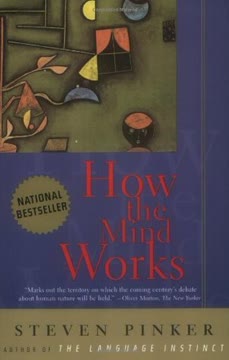Key Takeaways
1. The Mind is a Computational System
The mind is what the brain does; specifically, the brain processes information, and thinking is a kind of computation.
Brain as information processor. The brain's special status comes from its ability to process information, which underlies seeing, thinking, feeling, choosing, and acting. This information processing, or computation, is independent of the physical medium, much like a phone message remains the same whether it's air vibrations, electricity, or light signals. This insight, the computational theory of mind, bridges the gap between the physical brain and the ethereal world of thoughts and meanings.
Meaning as physical states. Beliefs and desires are information encoded as configurations of symbols, which are physical states of matter (like neurons). These symbols represent things in the world because they are triggered by those things and because their physical interactions mirror logical relationships. This allows meaning to be both a cause and an effect within the physical universe, resolving the mind-body problem.
Beyond the computer metaphor. The claim is not that the brain is like a desktop computer (serial, fast, reliable parts), but that both brains and computers embody intelligence through computation. Just as principles of aerodynamics explain bird and airplane flight, principles of computation explain intelligence in both biological and artificial systems, regardless of their specific hardware differences.
2. The Mind is Organized into Specialized Modules
The mind, like the Apollo spacecraft, is designed to solve many engineering problems, and thus is packed with high-tech systems each contrived to overcome its own obstacles.
Specialization is key. Just as the body is composed of specialized organs (heart for pumping blood, lungs for oxygenating), the mind is a system of mental organs or modules, each with a design tailored for a specific task. A jack-of-all-trades is master of none, and this applies to mental faculties as well; a single, general-purpose system cannot efficiently solve the diverse problems the mind faces.
Solving unsolvable problems. Many mental tasks, like vision (inverse optics) or motor control (inverse kinematics), are mathematically ill-posed – they have no unique solution based on the input alone. Mental modules overcome this by making indispensable, built-in assumptions about the world, turning unsolvable problems into solvable ones under typical conditions. For example:
- Vision assumes the world is evenly lit and surfaces are uniformly colored.
- Common sense assumes other people have beliefs and desires.
- Kinship feelings assume genetic relatedness based on appearance or upbringing.
Modules as mental organs. Mental modules are not necessarily physically distinct, circumscribed areas in the brain. They are defined by the specialized computations they perform, potentially distributed across interconnected brain regions, much like bodily organs are integrated into systems.
3. The Mind is a Product of Natural Selection
Our organs of computation are a product of natural selection. The biologist Richard Dawkins called natural selection the Blind Watchmaker; in the case of the mind, we can call it the Blind Programmer.
Evolutionary engineering. Natural selection is the only known non-miraculous process that can "design" complex, functional organs that accomplish improbable but adaptive outcomes. The intricate design of the eye, an organ of information processing connected to the brain, is a prime example, suggesting that the brain itself is also a product of this process.
Mind adapted to the Stone Age. The human mind's basic logic and design were shaped by natural selection to solve the problems faced by our evolutionary ancestors in their foraging way of life over millions of years. This means our minds are adapted to the challenges of the Pleistocene savanna, not to modern agricultural or industrial civilizations.
Behavior vs. mind. Natural selection does not directly program behavior; it designs the mind, which generates behavior. The mind is equipped with "if... then... else" imperatives, not rigid "Thou shalt..." commands. Behavior is the outcome of complex interactions among mental modules and environmental factors, not a direct expression of genes.
4. Vision Solves Unsolvable Problems with Built-in Assumptions
Vision has evolved to convert these ill-posed problems into solvable ones by adding premises: assumptions about how the world we evolved in is, on average, put together.
From image to description. Vision's task is to produce a description of the external world (objects, shapes, materials) from the two-dimensional images projected onto the retinas. This is an ill-posed problem because infinite 3D arrangements can produce the same 2D image.
Assumptions fill the gaps. The visual system solves this by making assumptions about the world, such as:
- Surfaces are uniformly colored and textured.
- Objects don't align in accidentally confusing ways.
- Matter is cohesive and smooth.
- The viewpoint is generic, not precisely aligned to create illusions.
Illusions reveal assumptions. When the real world violates these built-in assumptions (e.g., in Ames rooms, paintings, or stereograms), the visual system is fooled, and we experience illusions. These illusions are valuable to scientists because they expose the mind's hidden assumptions.
5. Common Sense is a Complex Engineering Feat
Knowing who is a bachelor is just common sense, but there's nothing common about common sense.
Implicit, vast knowledge. Common sense is the intuitive understanding of how the world works, including facts we tacitly know without being taught (e.g., when a person goes to church, their head goes with them). This knowledge is too vast to be stored as a simple database of facts.
Rules and the frame problem. Common sense must rely on a smaller set of core truths and rules to deduce implications. However, even simple rules are hard to formalize, and applying them intelligently requires distinguishing relevant implications from irrelevant ones – the "frame problem," which stumped early AI researchers but humans solve effortlessly.
Intuitive psychology. A crucial part of common sense is intuitive psychology, our ability to infer others' beliefs and desires and predict their actions. This system makes the indispensable assumption that others have minds, allowing us to navigate the social world effectively.
6. Human Reasoning Relies on Intuitive Theories
People form two kinds of categories... Fuzzy categories... and... categories that have definitions...
Beyond associationism. Human reasoning is not simply based on associating ideas by contiguity or resemblance, as proposed by traditional associationism. While neural networks can model these associative processes and form fuzzy categories based on correlations (like "game" or "vegetable"), they struggle with the precision and structure of human thought.
Intuitive theories and crisp categories. The mind also forms categories based on underlying laws and definitions, creating "crisp" categories (like "odd number" or "female"). These categories are part of intuitive theories about different domains of the world, such as:
- Physics (objects, motion, force)
- Biology (living things, essences, inheritance)
- Psychology (minds, beliefs, desires)
- Mathematics (number, quantity, geometry)
Reasoning by deduction. These intuitive theories allow for reasoning by deduction, transcending mere similarity. For example, knowing a caterpillar turns into a butterfly overrides the visual similarity between a caterpillar and a centipede, correctly classifying the former two as the same animal.
7. Emotions are Goal-Setting Mechanisms
The emotions are mechanisms that set the brain's highest-level goals.
Emotions as adaptive software. Emotions are not irrational urges or vestiges of an animal past, but well-engineered software modules that work with the intellect. They are adaptations that set the mind's priorities and mobilize resources to meet challenges relevant to survival and reproduction.
Triggering cascades. Once triggered by a situation (e.g., danger, opportunity), an emotion initiates a cascade of subgoals, thoughts, and physiological responses (like the fight-or-flight response in fear). This integration of feeling, thinking, and acting is indispensable for navigating the world effectively.
Beyond the Four Fs. While basic emotions like fear and disgust deal with physical challenges (predators, contaminants), many human emotions are tailored for social challenges. These emotions, like anger, gratitude, shame, and love, are complex strategies played out in response to other people's emotions and actions.
8. Social Relationships are Shaped by Evolutionary Logic
The love of kin comes naturally; the love of non-kin does not.
Kin selection. Altruism towards relatives is explained by kin selection: genes that promote helping relatives increase their own replication, as relatives share copies of those genes. This underlies the universal human tendency to feel solidarity, sympathy, tolerance, and trust towards kin, proportional to genetic relatedness.
Reciprocal altruism. Cooperation among non-relatives is explained by reciprocal altruism, which can evolve when individuals interact repeatedly and can remember and reciprocate favors. This requires sophisticated cognitive machinery for recognizing individuals, tracking favors given and received, and detecting cheaters.
Moralistic emotions. Emotions like liking, anger, gratitude, sympathy, guilt, and shame are adaptations that regulate reciprocal altruism. They motivate initiating cooperation, punishing cheaters, rewarding cooperators, and making amends, enabling complex social exchanges.
9. Romantic Love and Jealousy are Paradoxical Commitments
Offering to spend your life and raise children with someone is the most important promise you'll ever make, and a promise is most credible when the promiser can't back out.
Commitment as a strategy. Romantic love, with its irrationality and uncontrollability, may function as a commitment device. By falling genuinely, uncontrollably in love with a specific individual, a person signals that they are committed to the relationship beyond mere rational calculation of mate value, making them a more trustworthy partner.
Sex differences in desire. Men, with a lower minimum parental investment (sperm vs. egg, pregnancy, nursing), have a greater potential reproductive payoff from mating with multiple partners. This has led to a greater male desire for sexual variety compared to women, who are limited by the number of pregnancies they can carry.
Mate preferences. Evolutionary pressures have shaped sex differences in mate preferences. Women tend to value resources, status, ambition, and dependability in a long-term partner (qualities that predict ability and willingness to invest in offspring). Men tend to value youth and physical attractiveness (qualities that predict fertility and reproductive value).
10. Arts, Humor, Religion, and Philosophy are By-products of Mental Faculties
Why do we pursue the trivial and futile and experience them as sublime?
Non-adaptive pleasures. Activities like arts, music, and humor may not be adaptations themselves, but rather "auditory/visual cheesecake" – technologies that exploit and stimulate pleasure circuits in the brain that evolved for other purposes (e.g., enjoying sweet tastes, recognizing patterns, responding to emotional calls).
Cognitive spandrels. Religion and philosophy may arise from applying mental faculties designed for mundane problems (intuitive physics, biology, psychology) to questions they were not designed to answer (origin of the universe, consciousness, free will, morality). This can lead to imaginative but often logically inconsistent beliefs.
Status and social signaling. Many aspects of arts, humor, and religion are also intertwined with the psychology of status and social signaling. Conspicuous consumption of art, witty remarks, or adherence to religious rituals can serve to advertise one's position or group membership.
11. Sentience Remains a Profound Mystery
How can a book called How the Mind Works evade the responsibility of explaining where sentience comes from?
The hard problem. While science can explain consciousness in terms of information access (what information is available to which mental processes) and self-knowledge (having a mental model of oneself), it offers no clear explanation for sentience – the subjective, qualitative experience of feeling or seeing.
Beyond scientific grasp? Problems like sentience, the nature of the self, free will, meaning, and morality may be fundamentally beyond the cognitive equipment that natural selection has fitted us with. Our minds evolved to solve problems relevant to survival and reproduction, not to grasp all possible truths.
Mismatch with combinatorial mind. These philosophical mysteries seem to possess a holistic, non-combinatorial nature that mismatches the combinatorial, part-based computational apparatus of the human mind. While we can analyze objects into parts or deduce conclusions from premises, we struggle to conceive how subjective experience or free will could arise from combinations of simpler elements or causal chains.
Last updated:
Review Summary
How the Mind Works presents a computational theory of the mind and evolutionary psychology, exploring human cognition, emotions, and behavior. Reviews praise Pinker's engaging writing and synthesis of research, though some criticize the book's length and outdated information. Readers appreciate the insights into human nature and cognitive processes, but some find certain sections tedious or disagree with Pinker's arguments. Overall, the book is viewed as thought-provoking and influential, despite its controversial aspects and occasional dense explanations.
Language and Human Nature Tetralogy Series
Similar Books









Download PDF
Download EPUB
.epub digital book format is ideal for reading ebooks on phones, tablets, and e-readers.










